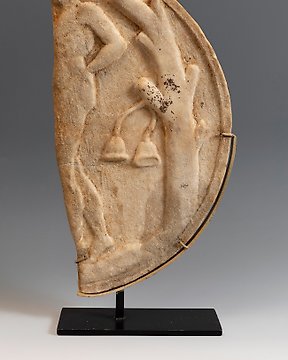
Romersk antik Marmor Oscillum Fragment. 1. - 2. århundrede e.Kr. Højde 38 cm.
Nr. 83864057

Nr. 83864057

Attis sculpture's head
CULTURE: Roman Empire
PERIOD: 2nd - 3rd century AD
MATERIAL: Marble
DIMENSIONS: Height 24 cm with stand, 13,5 cm height witout stand.
PROVENANCE: Private collection, Paris, France. 1970 - 1980.
CONDITION: Intact, good state.
DESCRIPTION:
Round head representing the face of the god Attis, which can be deduced by the presence of the Phrygian cap. The work stands out for the quality of the carving, of fine and rounded forms, although the lack of idealization in the features is also appreciated, in favor of a greater realism that was a common characteristic in the Roman sculpture of the II-III centuries AD, in which the aesthetics had become detached from the ideal of Greek statuary. Attis, a Greek god adopted from the Phrygians and who in turn was also venerated by the Romans. God of lost and rediscovered vegetation, he personifies the ephemeral and revived spring. Attis represents the nature that dies in autumn and that rises again in spring. This oriental divinity has its origins in Phrygia and several versions of the mythological legend are known, always highlighting his death due to self-castration and his subsequent resurrection. He was considered the lover of the goddess Cybele. In the Roman world we find representations of Attis in all kinds of artistic manifestations, among which we want to highlight the sculpture. His iconography is very varied, since this divinity is presented in different attitudes, sometimes alone and sometimes in the company of Cybele. This diversity is due to the desire to show the god in the most relevant moments of his myth or to express through his image ideologies of symbolic-religious content. We must highlight those figures that represent him as the protector deity of the dead and their resurrection, in this case without any relation to Cybele, since he had also known suffering and death and had overcome them.
Precisely, Roman sculpture stood out from Greek sculpture in the creation of the sculpture-portrait. The Roman portrait has its roots in Etruscan art, but also in the Hellenistic Greek world and in the "masks mayorum", that is, wax masks that were applied to the faces of the deceased for their memory and later worship. The materials most commonly used in Roman portraiture were bronze and marble. At the beginning, Roman portrait sculpture only represented the head and part of the neck. Later, progress was made in the representation of the entire bust, including shoulders and chest. However, full body sculptures were also sculpted, as in the one presented here.
Notes:
The seller guarantees that he acquired this piece according to all national and international laws related to the ownership of cultural property. Provenance statement seen by Catawiki.
The piece includes authenticity certificate.
The piece includes Spanish Export License (Passport for European Union) - If the piece is destined outside the European Union a substitution of the export permit should be requested.
THE MINISTRY OF CULTURE FROM SPAIN ASKS ALL SELLERS FOR INVOICES OR OTHER DOCUMENTATION ABLE TO PROVE THE LEGALITY OF EACH ITEM BEFORE PROVIDING AN IMPORT OR EXPORT LICENSE.
#ExclusiveJurassicAntiquity
Sådan køber du hos Catawiki
1. Opdag noget særligt
2. Afgiv det højeste bud
3. Foretag en sikker betaling